Transcranial Magnetic Stimulation: A Critical Analysis of rTMS
VerifiedAdded on 2023/05/28
|10
|2179
|248
Report
AI Summary
This report provides a critical analysis of the claims made in an online article regarding the benefits of repetitive transcranial magnetic stimulation (rTMS) for treating auditory disorders, depression, and enhancing memory and learning. The analysis incorporates scientific evidence from databases like COCHRANE, MedLine, BioMed, and PubMed. It discusses the overview and side effects of rTMS, its usage in treating hearing disorders and drug addiction, its application in auditory cortex problems and major depression, and its potential for enhancing memory and learning. The report also addresses the claim about the need for detoxification before rTMS treatment, finding no scientific evidence to support it. The conclusion highlights the potential benefits of rTMS in treating hearing and neurological disorders and emphasizes the importance of verifying claims with credible research, noting that while some claims are supported by evidence, others lack scientific justification. Desklib offers more solved assignments and past papers for students.
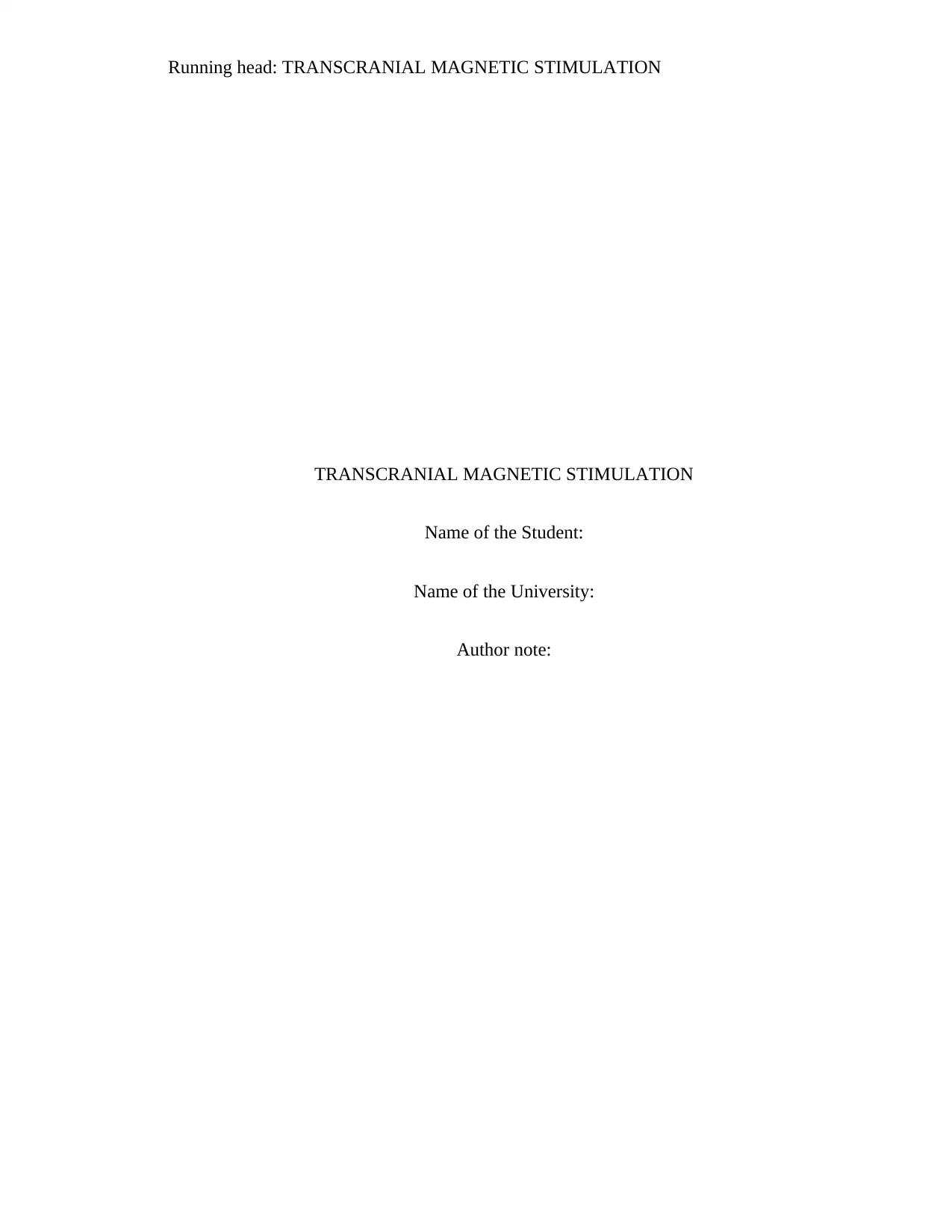
Running head: TRANSCRANIAL MAGNETIC STIMULATION
TRANSCRANIAL MAGNETIC STIMULATION
Name of the Student:
Name of the University:
Author note:
TRANSCRANIAL MAGNETIC STIMULATION
Name of the Student:
Name of the University:
Author note:
Paraphrase This Document
Need a fresh take? Get an instant paraphrase of this document with our AI Paraphraser
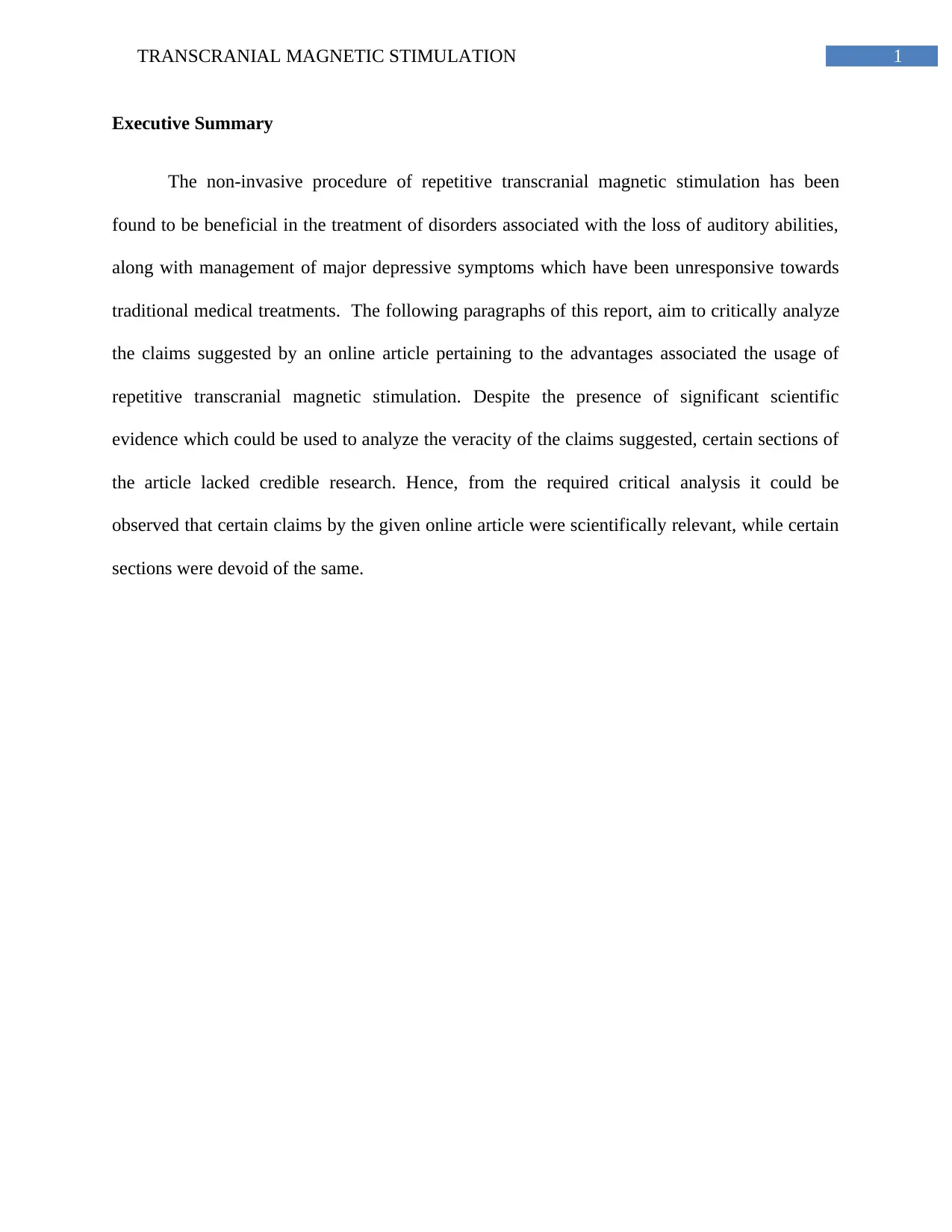
1TRANSCRANIAL MAGNETIC STIMULATION
Executive Summary
The non-invasive procedure of repetitive transcranial magnetic stimulation has been
found to be beneficial in the treatment of disorders associated with the loss of auditory abilities,
along with management of major depressive symptoms which have been unresponsive towards
traditional medical treatments. The following paragraphs of this report, aim to critically analyze
the claims suggested by an online article pertaining to the advantages associated the usage of
repetitive transcranial magnetic stimulation. Despite the presence of significant scientific
evidence which could be used to analyze the veracity of the claims suggested, certain sections of
the article lacked credible research. Hence, from the required critical analysis it could be
observed that certain claims by the given online article were scientifically relevant, while certain
sections were devoid of the same.
Executive Summary
The non-invasive procedure of repetitive transcranial magnetic stimulation has been
found to be beneficial in the treatment of disorders associated with the loss of auditory abilities,
along with management of major depressive symptoms which have been unresponsive towards
traditional medical treatments. The following paragraphs of this report, aim to critically analyze
the claims suggested by an online article pertaining to the advantages associated the usage of
repetitive transcranial magnetic stimulation. Despite the presence of significant scientific
evidence which could be used to analyze the veracity of the claims suggested, certain sections of
the article lacked credible research. Hence, from the required critical analysis it could be
observed that certain claims by the given online article were scientifically relevant, while certain
sections were devoid of the same.
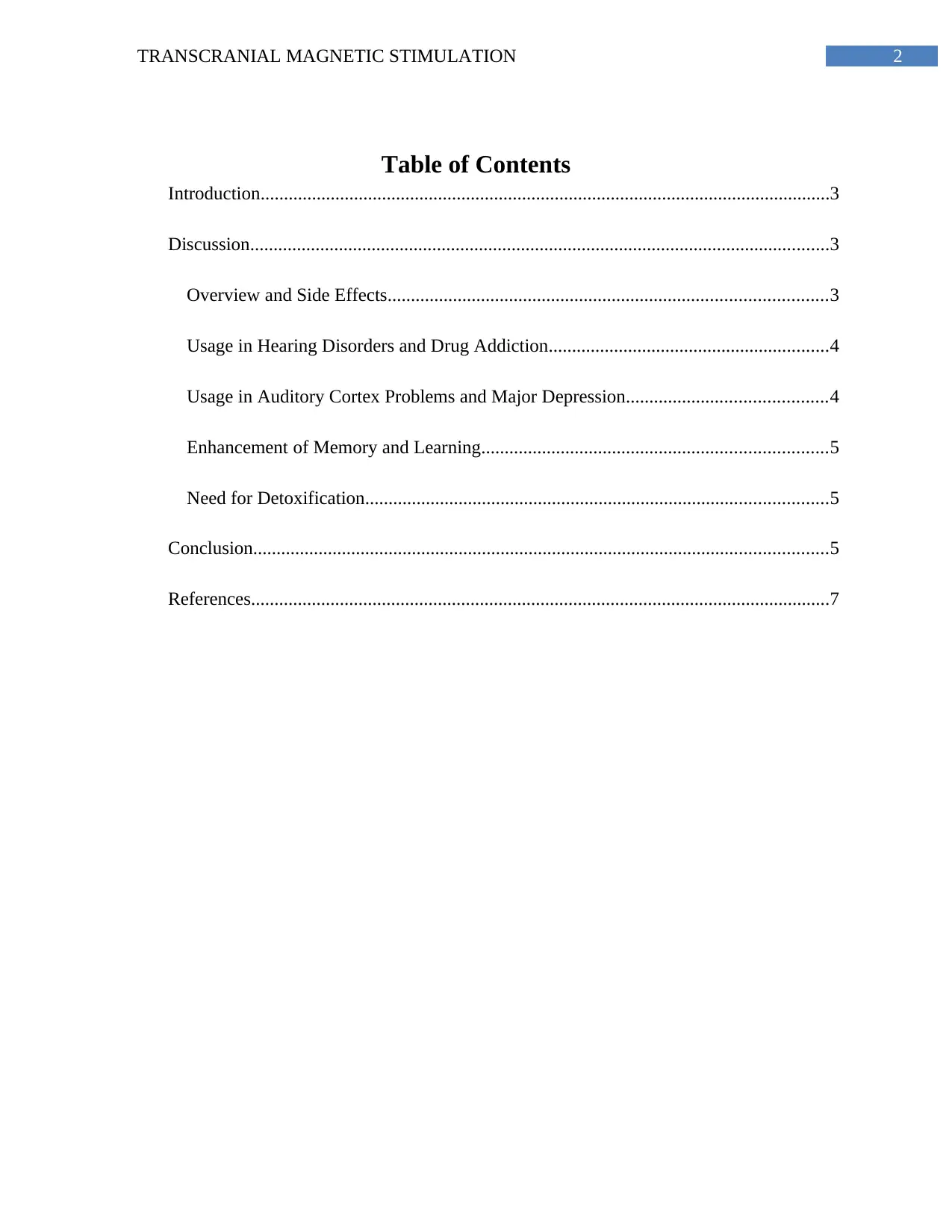
2TRANSCRANIAL MAGNETIC STIMULATION
Table of Contents
Introduction..........................................................................................................................3
Discussion............................................................................................................................3
Overview and Side Effects..............................................................................................3
Usage in Hearing Disorders and Drug Addiction............................................................4
Usage in Auditory Cortex Problems and Major Depression...........................................4
Enhancement of Memory and Learning..........................................................................5
Need for Detoxification...................................................................................................5
Conclusion...........................................................................................................................5
References............................................................................................................................7
Table of Contents
Introduction..........................................................................................................................3
Discussion............................................................................................................................3
Overview and Side Effects..............................................................................................3
Usage in Hearing Disorders and Drug Addiction............................................................4
Usage in Auditory Cortex Problems and Major Depression...........................................4
Enhancement of Memory and Learning..........................................................................5
Need for Detoxification...................................................................................................5
Conclusion...........................................................................................................................5
References............................................................................................................................7
⊘ This is a preview!⊘
Do you want full access?
Subscribe today to unlock all pages.

Trusted by 1+ million students worldwide
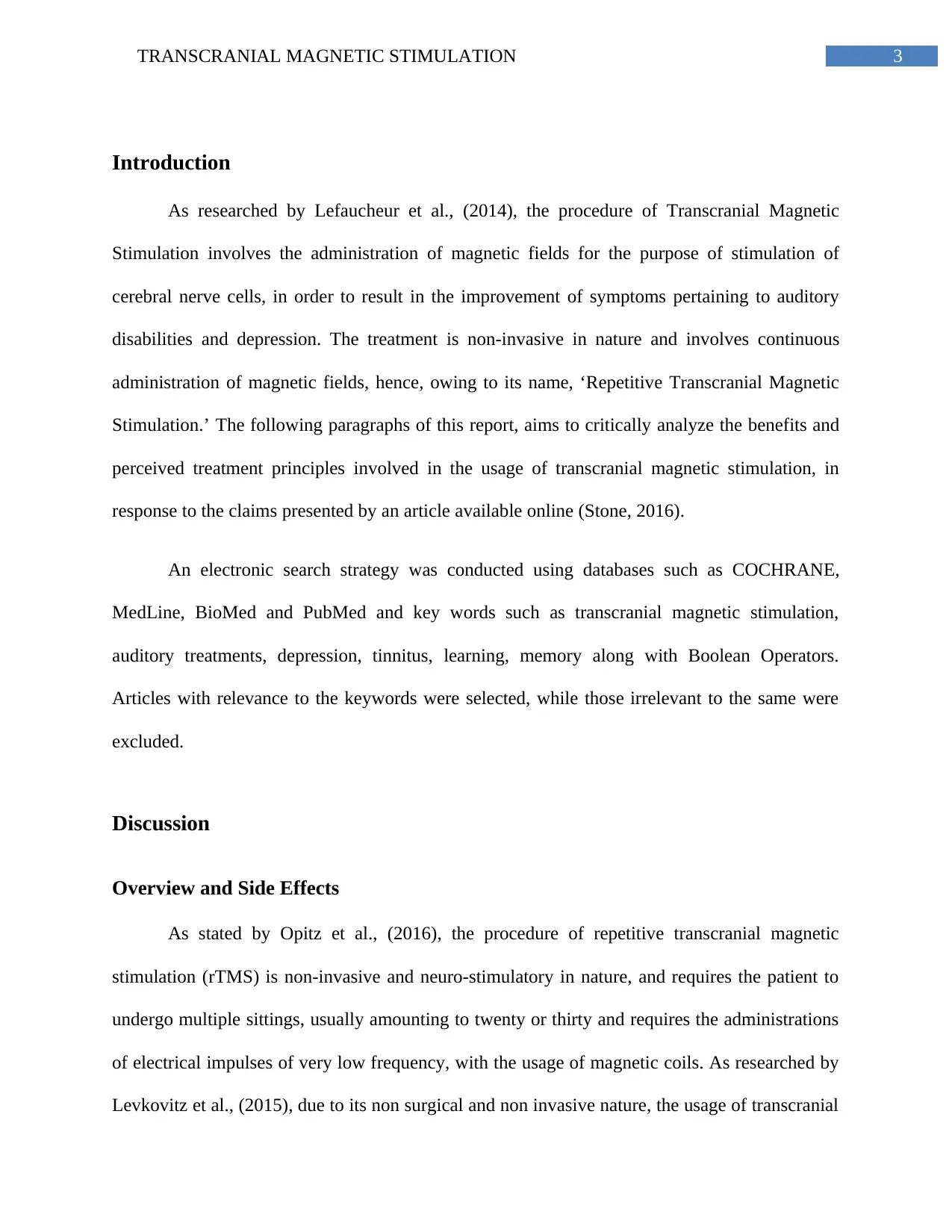
3TRANSCRANIAL MAGNETIC STIMULATION
Introduction
As researched by Lefaucheur et al., (2014), the procedure of Transcranial Magnetic
Stimulation involves the administration of magnetic fields for the purpose of stimulation of
cerebral nerve cells, in order to result in the improvement of symptoms pertaining to auditory
disabilities and depression. The treatment is non-invasive in nature and involves continuous
administration of magnetic fields, hence, owing to its name, ‘Repetitive Transcranial Magnetic
Stimulation.’ The following paragraphs of this report, aims to critically analyze the benefits and
perceived treatment principles involved in the usage of transcranial magnetic stimulation, in
response to the claims presented by an article available online (Stone, 2016).
An electronic search strategy was conducted using databases such as COCHRANE,
MedLine, BioMed and PubMed and key words such as transcranial magnetic stimulation,
auditory treatments, depression, tinnitus, learning, memory along with Boolean Operators.
Articles with relevance to the keywords were selected, while those irrelevant to the same were
excluded.
Discussion
Overview and Side Effects
As stated by Opitz et al., (2016), the procedure of repetitive transcranial magnetic
stimulation (rTMS) is non-invasive and neuro-stimulatory in nature, and requires the patient to
undergo multiple sittings, usually amounting to twenty or thirty and requires the administrations
of electrical impulses of very low frequency, with the usage of magnetic coils. As researched by
Levkovitz et al., (2015), due to its non surgical and non invasive nature, the usage of transcranial
Introduction
As researched by Lefaucheur et al., (2014), the procedure of Transcranial Magnetic
Stimulation involves the administration of magnetic fields for the purpose of stimulation of
cerebral nerve cells, in order to result in the improvement of symptoms pertaining to auditory
disabilities and depression. The treatment is non-invasive in nature and involves continuous
administration of magnetic fields, hence, owing to its name, ‘Repetitive Transcranial Magnetic
Stimulation.’ The following paragraphs of this report, aims to critically analyze the benefits and
perceived treatment principles involved in the usage of transcranial magnetic stimulation, in
response to the claims presented by an article available online (Stone, 2016).
An electronic search strategy was conducted using databases such as COCHRANE,
MedLine, BioMed and PubMed and key words such as transcranial magnetic stimulation,
auditory treatments, depression, tinnitus, learning, memory along with Boolean Operators.
Articles with relevance to the keywords were selected, while those irrelevant to the same were
excluded.
Discussion
Overview and Side Effects
As stated by Opitz et al., (2016), the procedure of repetitive transcranial magnetic
stimulation (rTMS) is non-invasive and neuro-stimulatory in nature, and requires the patient to
undergo multiple sittings, usually amounting to twenty or thirty and requires the administrations
of electrical impulses of very low frequency, with the usage of magnetic coils. As researched by
Levkovitz et al., (2015), due to its non surgical and non invasive nature, the usage of transcranial
Paraphrase This Document
Need a fresh take? Get an instant paraphrase of this document with our AI Paraphraser
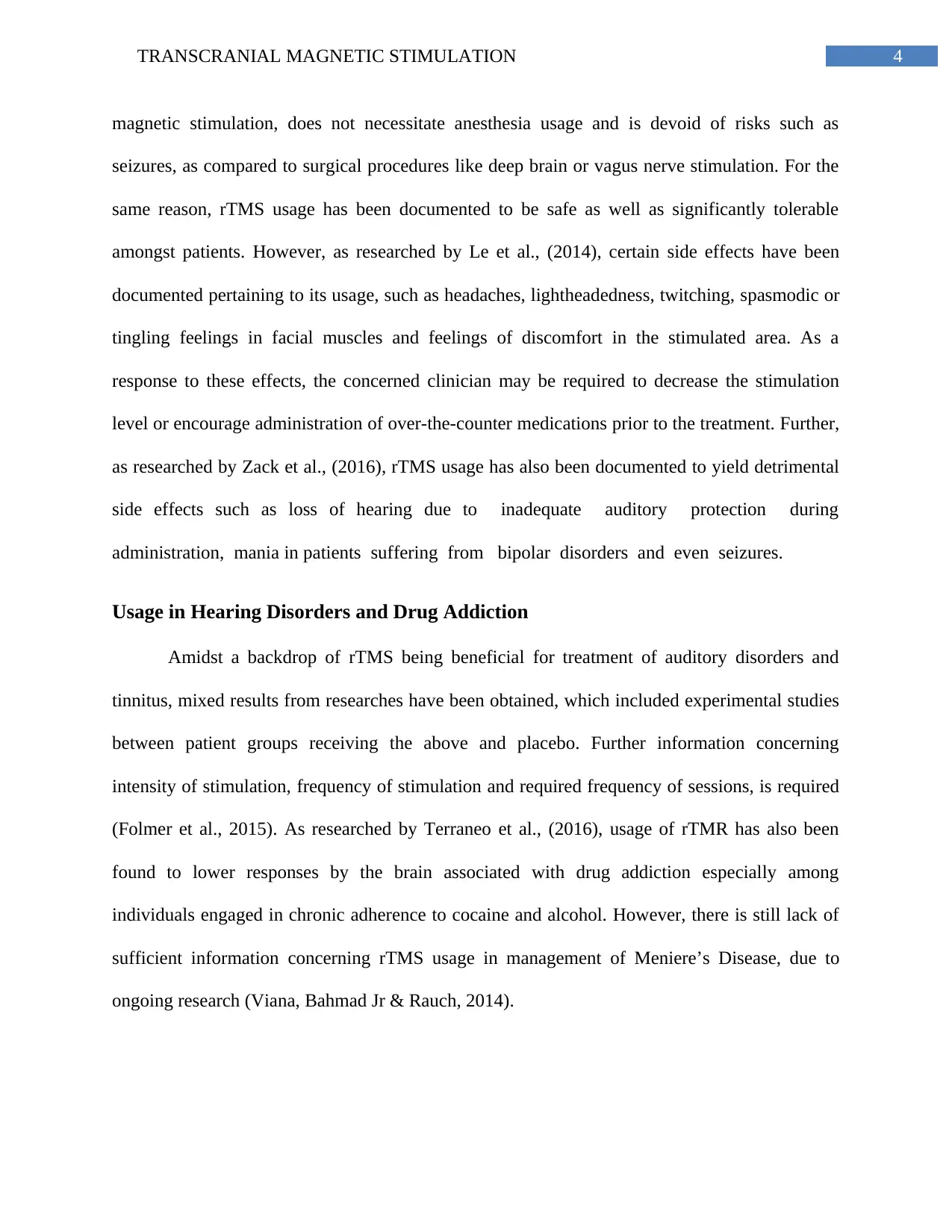
4TRANSCRANIAL MAGNETIC STIMULATION
magnetic stimulation, does not necessitate anesthesia usage and is devoid of risks such as
seizures, as compared to surgical procedures like deep brain or vagus nerve stimulation. For the
same reason, rTMS usage has been documented to be safe as well as significantly tolerable
amongst patients. However, as researched by Le et al., (2014), certain side effects have been
documented pertaining to its usage, such as headaches, lightheadedness, twitching, spasmodic or
tingling feelings in facial muscles and feelings of discomfort in the stimulated area. As a
response to these effects, the concerned clinician may be required to decrease the stimulation
level or encourage administration of over-the-counter medications prior to the treatment. Further,
as researched by Zack et al., (2016), rTMS usage has also been documented to yield detrimental
side effects such as loss of hearing due to inadequate auditory protection during
administration, mania in patients suffering from bipolar disorders and even seizures.
Usage in Hearing Disorders and Drug Addiction
Amidst a backdrop of rTMS being beneficial for treatment of auditory disorders and
tinnitus, mixed results from researches have been obtained, which included experimental studies
between patient groups receiving the above and placebo. Further information concerning
intensity of stimulation, frequency of stimulation and required frequency of sessions, is required
(Folmer et al., 2015). As researched by Terraneo et al., (2016), usage of rTMR has also been
found to lower responses by the brain associated with drug addiction especially among
individuals engaged in chronic adherence to cocaine and alcohol. However, there is still lack of
sufficient information concerning rTMS usage in management of Meniere’s Disease, due to
ongoing research (Viana, Bahmad Jr & Rauch, 2014).
magnetic stimulation, does not necessitate anesthesia usage and is devoid of risks such as
seizures, as compared to surgical procedures like deep brain or vagus nerve stimulation. For the
same reason, rTMS usage has been documented to be safe as well as significantly tolerable
amongst patients. However, as researched by Le et al., (2014), certain side effects have been
documented pertaining to its usage, such as headaches, lightheadedness, twitching, spasmodic or
tingling feelings in facial muscles and feelings of discomfort in the stimulated area. As a
response to these effects, the concerned clinician may be required to decrease the stimulation
level or encourage administration of over-the-counter medications prior to the treatment. Further,
as researched by Zack et al., (2016), rTMS usage has also been documented to yield detrimental
side effects such as loss of hearing due to inadequate auditory protection during
administration, mania in patients suffering from bipolar disorders and even seizures.
Usage in Hearing Disorders and Drug Addiction
Amidst a backdrop of rTMS being beneficial for treatment of auditory disorders and
tinnitus, mixed results from researches have been obtained, which included experimental studies
between patient groups receiving the above and placebo. Further information concerning
intensity of stimulation, frequency of stimulation and required frequency of sessions, is required
(Folmer et al., 2015). As researched by Terraneo et al., (2016), usage of rTMR has also been
found to lower responses by the brain associated with drug addiction especially among
individuals engaged in chronic adherence to cocaine and alcohol. However, there is still lack of
sufficient information concerning rTMS usage in management of Meniere’s Disease, due to
ongoing research (Viana, Bahmad Jr & Rauch, 2014).
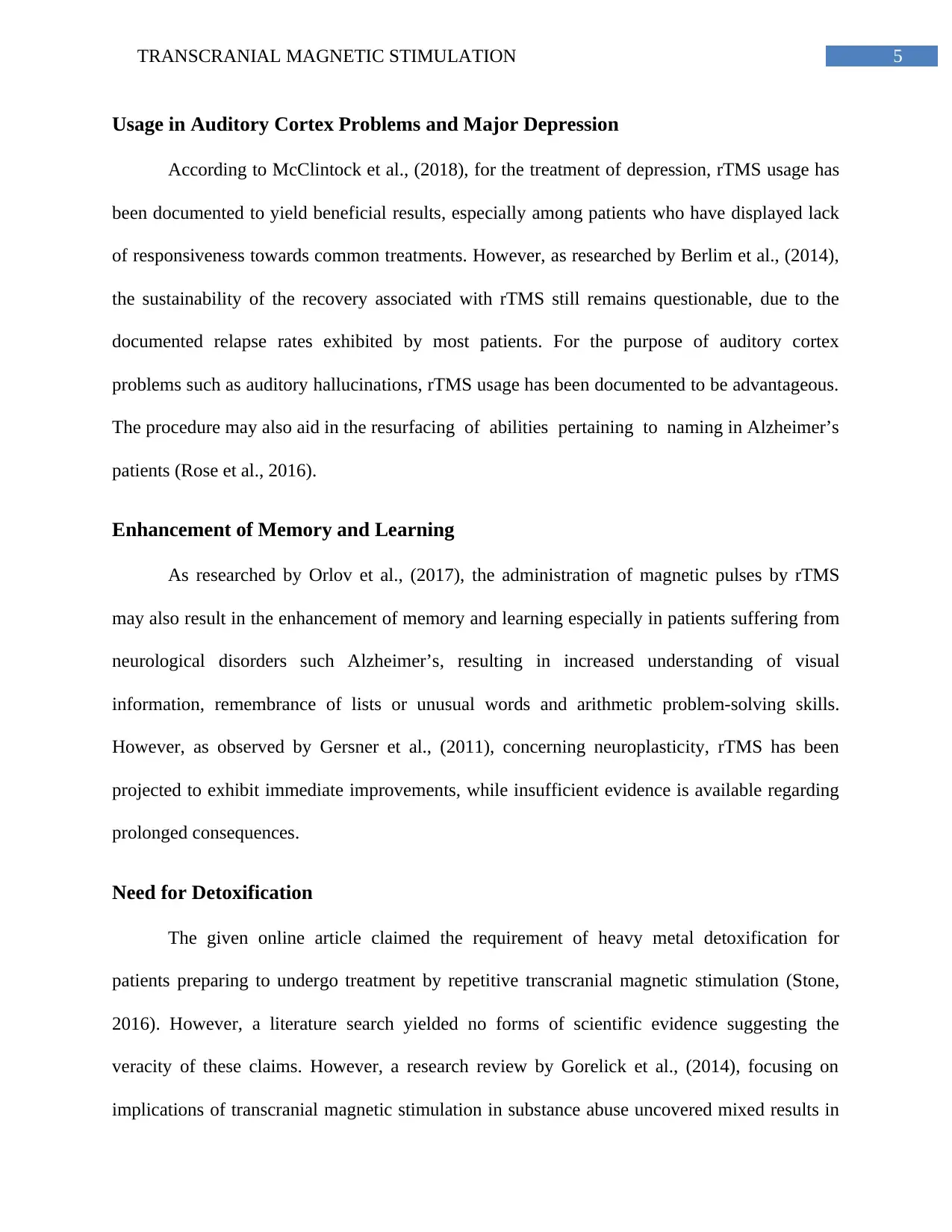
5TRANSCRANIAL MAGNETIC STIMULATION
Usage in Auditory Cortex Problems and Major Depression
According to McClintock et al., (2018), for the treatment of depression, rTMS usage has
been documented to yield beneficial results, especially among patients who have displayed lack
of responsiveness towards common treatments. However, as researched by Berlim et al., (2014),
the sustainability of the recovery associated with rTMS still remains questionable, due to the
documented relapse rates exhibited by most patients. For the purpose of auditory cortex
problems such as auditory hallucinations, rTMS usage has been documented to be advantageous.
The procedure may also aid in the resurfacing of abilities pertaining to naming in Alzheimer’s
patients (Rose et al., 2016).
Enhancement of Memory and Learning
As researched by Orlov et al., (2017), the administration of magnetic pulses by rTMS
may also result in the enhancement of memory and learning especially in patients suffering from
neurological disorders such Alzheimer’s, resulting in increased understanding of visual
information, remembrance of lists or unusual words and arithmetic problem-solving skills.
However, as observed by Gersner et al., (2011), concerning neuroplasticity, rTMS has been
projected to exhibit immediate improvements, while insufficient evidence is available regarding
prolonged consequences.
Need for Detoxification
The given online article claimed the requirement of heavy metal detoxification for
patients preparing to undergo treatment by repetitive transcranial magnetic stimulation (Stone,
2016). However, a literature search yielded no forms of scientific evidence suggesting the
veracity of these claims. However, a research review by Gorelick et al., (2014), focusing on
implications of transcranial magnetic stimulation in substance abuse uncovered mixed results in
Usage in Auditory Cortex Problems and Major Depression
According to McClintock et al., (2018), for the treatment of depression, rTMS usage has
been documented to yield beneficial results, especially among patients who have displayed lack
of responsiveness towards common treatments. However, as researched by Berlim et al., (2014),
the sustainability of the recovery associated with rTMS still remains questionable, due to the
documented relapse rates exhibited by most patients. For the purpose of auditory cortex
problems such as auditory hallucinations, rTMS usage has been documented to be advantageous.
The procedure may also aid in the resurfacing of abilities pertaining to naming in Alzheimer’s
patients (Rose et al., 2016).
Enhancement of Memory and Learning
As researched by Orlov et al., (2017), the administration of magnetic pulses by rTMS
may also result in the enhancement of memory and learning especially in patients suffering from
neurological disorders such Alzheimer’s, resulting in increased understanding of visual
information, remembrance of lists or unusual words and arithmetic problem-solving skills.
However, as observed by Gersner et al., (2011), concerning neuroplasticity, rTMS has been
projected to exhibit immediate improvements, while insufficient evidence is available regarding
prolonged consequences.
Need for Detoxification
The given online article claimed the requirement of heavy metal detoxification for
patients preparing to undergo treatment by repetitive transcranial magnetic stimulation (Stone,
2016). However, a literature search yielded no forms of scientific evidence suggesting the
veracity of these claims. However, a research review by Gorelick et al., (2014), focusing on
implications of transcranial magnetic stimulation in substance abuse uncovered mixed results in
⊘ This is a preview!⊘
Do you want full access?
Subscribe today to unlock all pages.

Trusted by 1+ million students worldwide
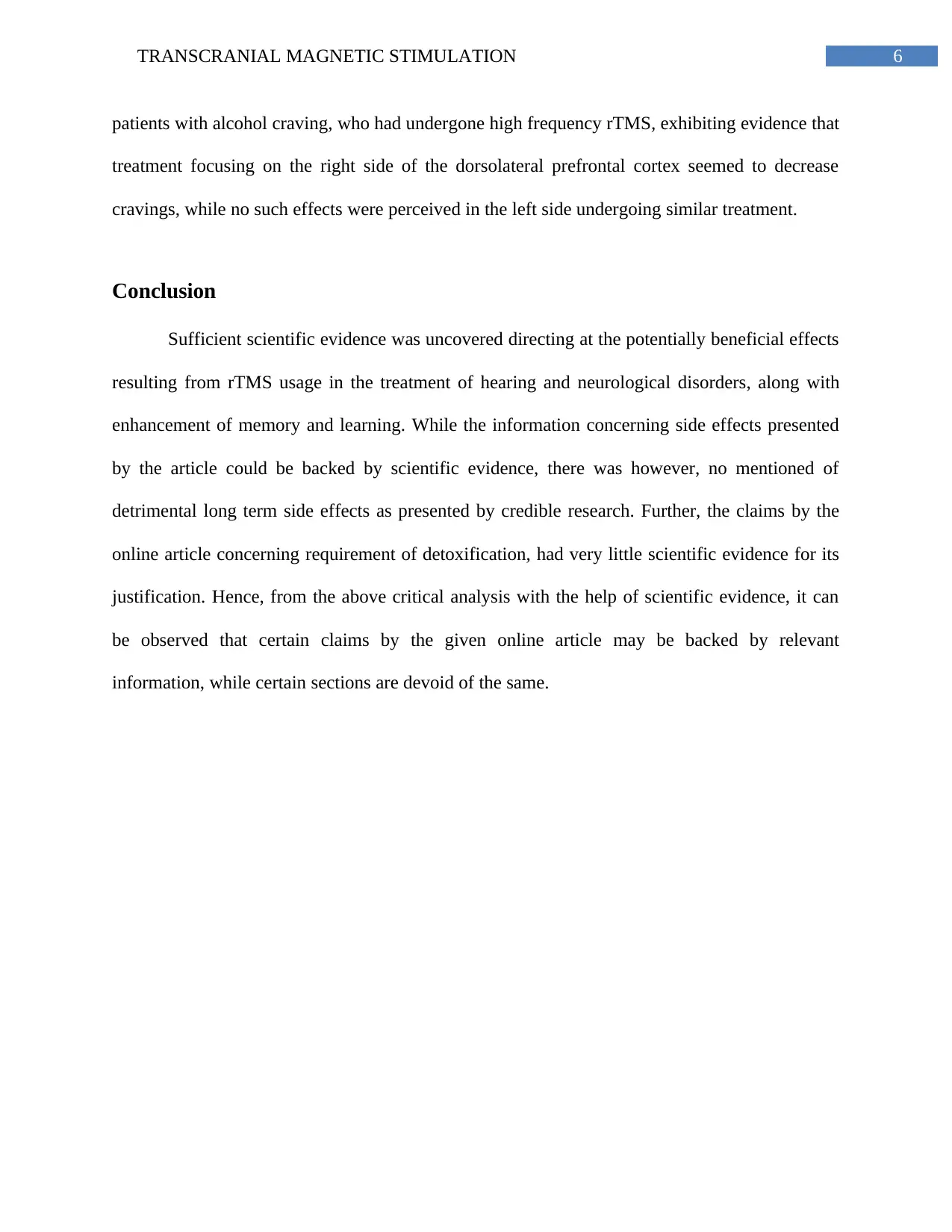
6TRANSCRANIAL MAGNETIC STIMULATION
patients with alcohol craving, who had undergone high frequency rTMS, exhibiting evidence that
treatment focusing on the right side of the dorsolateral prefrontal cortex seemed to decrease
cravings, while no such effects were perceived in the left side undergoing similar treatment.
Conclusion
Sufficient scientific evidence was uncovered directing at the potentially beneficial effects
resulting from rTMS usage in the treatment of hearing and neurological disorders, along with
enhancement of memory and learning. While the information concerning side effects presented
by the article could be backed by scientific evidence, there was however, no mentioned of
detrimental long term side effects as presented by credible research. Further, the claims by the
online article concerning requirement of detoxification, had very little scientific evidence for its
justification. Hence, from the above critical analysis with the help of scientific evidence, it can
be observed that certain claims by the given online article may be backed by relevant
information, while certain sections are devoid of the same.
patients with alcohol craving, who had undergone high frequency rTMS, exhibiting evidence that
treatment focusing on the right side of the dorsolateral prefrontal cortex seemed to decrease
cravings, while no such effects were perceived in the left side undergoing similar treatment.
Conclusion
Sufficient scientific evidence was uncovered directing at the potentially beneficial effects
resulting from rTMS usage in the treatment of hearing and neurological disorders, along with
enhancement of memory and learning. While the information concerning side effects presented
by the article could be backed by scientific evidence, there was however, no mentioned of
detrimental long term side effects as presented by credible research. Further, the claims by the
online article concerning requirement of detoxification, had very little scientific evidence for its
justification. Hence, from the above critical analysis with the help of scientific evidence, it can
be observed that certain claims by the given online article may be backed by relevant
information, while certain sections are devoid of the same.
Paraphrase This Document
Need a fresh take? Get an instant paraphrase of this document with our AI Paraphraser
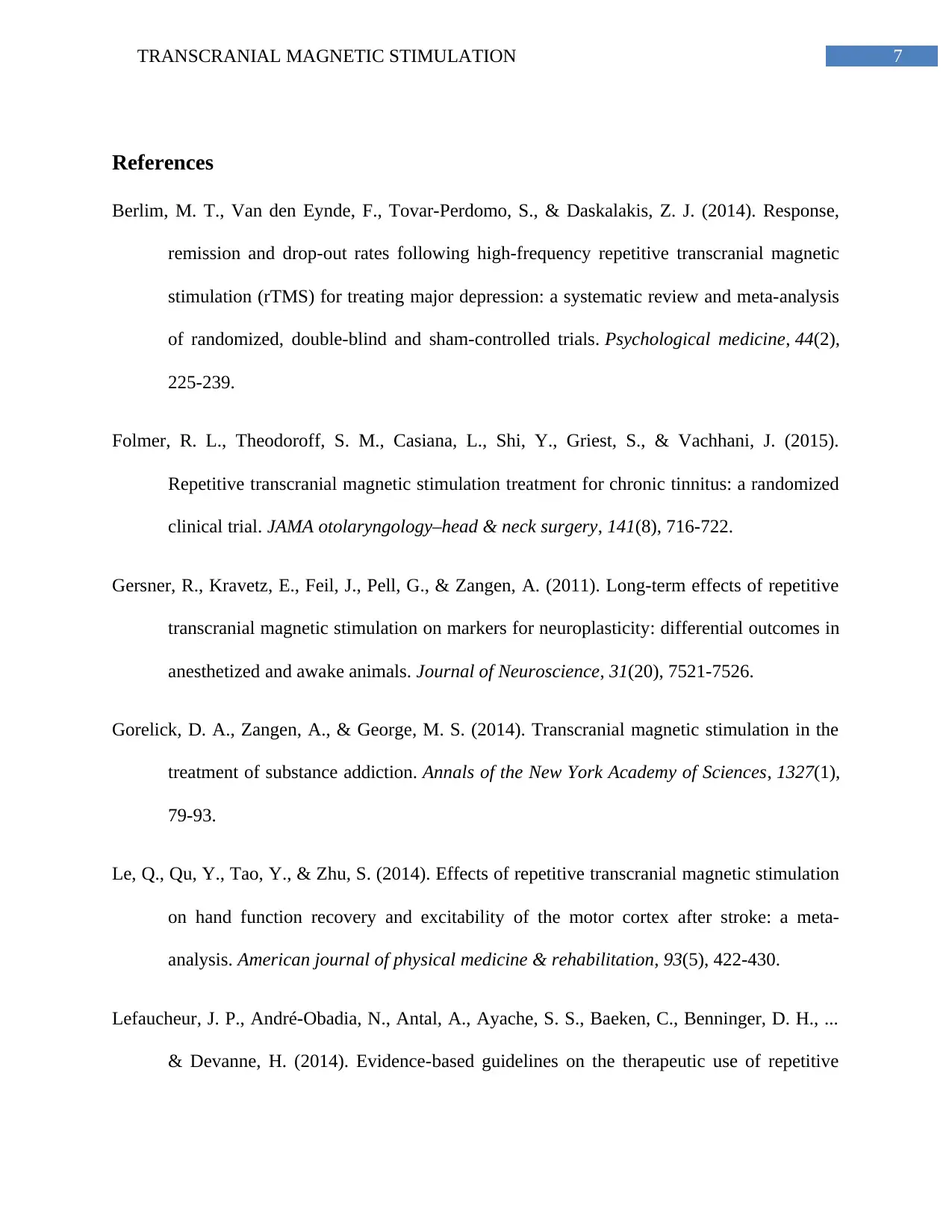
7TRANSCRANIAL MAGNETIC STIMULATION
References
Berlim, M. T., Van den Eynde, F., Tovar-Perdomo, S., & Daskalakis, Z. J. (2014). Response,
remission and drop-out rates following high-frequency repetitive transcranial magnetic
stimulation (rTMS) for treating major depression: a systematic review and meta-analysis
of randomized, double-blind and sham-controlled trials. Psychological medicine, 44(2),
225-239.
Folmer, R. L., Theodoroff, S. M., Casiana, L., Shi, Y., Griest, S., & Vachhani, J. (2015).
Repetitive transcranial magnetic stimulation treatment for chronic tinnitus: a randomized
clinical trial. JAMA otolaryngology–head & neck surgery, 141(8), 716-722.
Gersner, R., Kravetz, E., Feil, J., Pell, G., & Zangen, A. (2011). Long-term effects of repetitive
transcranial magnetic stimulation on markers for neuroplasticity: differential outcomes in
anesthetized and awake animals. Journal of Neuroscience, 31(20), 7521-7526.
Gorelick, D. A., Zangen, A., & George, M. S. (2014). Transcranial magnetic stimulation in the
treatment of substance addiction. Annals of the New York Academy of Sciences, 1327(1),
79-93.
Le, Q., Qu, Y., Tao, Y., & Zhu, S. (2014). Effects of repetitive transcranial magnetic stimulation
on hand function recovery and excitability of the motor cortex after stroke: a meta-
analysis. American journal of physical medicine & rehabilitation, 93(5), 422-430.
Lefaucheur, J. P., André-Obadia, N., Antal, A., Ayache, S. S., Baeken, C., Benninger, D. H., ...
& Devanne, H. (2014). Evidence-based guidelines on the therapeutic use of repetitive
References
Berlim, M. T., Van den Eynde, F., Tovar-Perdomo, S., & Daskalakis, Z. J. (2014). Response,
remission and drop-out rates following high-frequency repetitive transcranial magnetic
stimulation (rTMS) for treating major depression: a systematic review and meta-analysis
of randomized, double-blind and sham-controlled trials. Psychological medicine, 44(2),
225-239.
Folmer, R. L., Theodoroff, S. M., Casiana, L., Shi, Y., Griest, S., & Vachhani, J. (2015).
Repetitive transcranial magnetic stimulation treatment for chronic tinnitus: a randomized
clinical trial. JAMA otolaryngology–head & neck surgery, 141(8), 716-722.
Gersner, R., Kravetz, E., Feil, J., Pell, G., & Zangen, A. (2011). Long-term effects of repetitive
transcranial magnetic stimulation on markers for neuroplasticity: differential outcomes in
anesthetized and awake animals. Journal of Neuroscience, 31(20), 7521-7526.
Gorelick, D. A., Zangen, A., & George, M. S. (2014). Transcranial magnetic stimulation in the
treatment of substance addiction. Annals of the New York Academy of Sciences, 1327(1),
79-93.
Le, Q., Qu, Y., Tao, Y., & Zhu, S. (2014). Effects of repetitive transcranial magnetic stimulation
on hand function recovery and excitability of the motor cortex after stroke: a meta-
analysis. American journal of physical medicine & rehabilitation, 93(5), 422-430.
Lefaucheur, J. P., André-Obadia, N., Antal, A., Ayache, S. S., Baeken, C., Benninger, D. H., ...
& Devanne, H. (2014). Evidence-based guidelines on the therapeutic use of repetitive
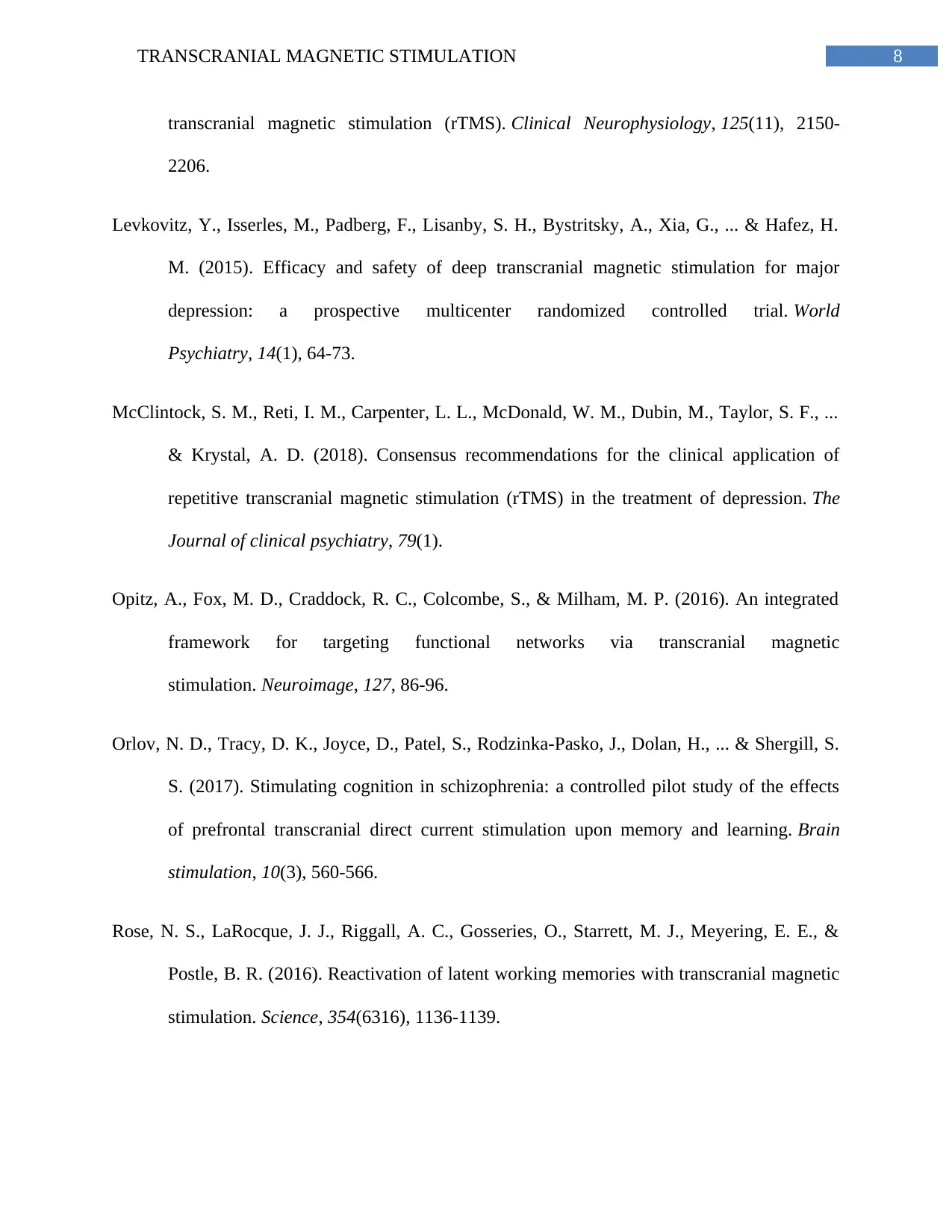
8TRANSCRANIAL MAGNETIC STIMULATION
transcranial magnetic stimulation (rTMS). Clinical Neurophysiology, 125(11), 2150-
2206.
Levkovitz, Y., Isserles, M., Padberg, F., Lisanby, S. H., Bystritsky, A., Xia, G., ... & Hafez, H.
M. (2015). Efficacy and safety of deep transcranial magnetic stimulation for major
depression: a prospective multicenter randomized controlled trial. World
Psychiatry, 14(1), 64-73.
McClintock, S. M., Reti, I. M., Carpenter, L. L., McDonald, W. M., Dubin, M., Taylor, S. F., ...
& Krystal, A. D. (2018). Consensus recommendations for the clinical application of
repetitive transcranial magnetic stimulation (rTMS) in the treatment of depression. The
Journal of clinical psychiatry, 79(1).
Opitz, A., Fox, M. D., Craddock, R. C., Colcombe, S., & Milham, M. P. (2016). An integrated
framework for targeting functional networks via transcranial magnetic
stimulation. Neuroimage, 127, 86-96.
Orlov, N. D., Tracy, D. K., Joyce, D., Patel, S., Rodzinka-Pasko, J., Dolan, H., ... & Shergill, S.
S. (2017). Stimulating cognition in schizophrenia: a controlled pilot study of the effects
of prefrontal transcranial direct current stimulation upon memory and learning. Brain
stimulation, 10(3), 560-566.
Rose, N. S., LaRocque, J. J., Riggall, A. C., Gosseries, O., Starrett, M. J., Meyering, E. E., &
Postle, B. R. (2016). Reactivation of latent working memories with transcranial magnetic
stimulation. Science, 354(6316), 1136-1139.
transcranial magnetic stimulation (rTMS). Clinical Neurophysiology, 125(11), 2150-
2206.
Levkovitz, Y., Isserles, M., Padberg, F., Lisanby, S. H., Bystritsky, A., Xia, G., ... & Hafez, H.
M. (2015). Efficacy and safety of deep transcranial magnetic stimulation for major
depression: a prospective multicenter randomized controlled trial. World
Psychiatry, 14(1), 64-73.
McClintock, S. M., Reti, I. M., Carpenter, L. L., McDonald, W. M., Dubin, M., Taylor, S. F., ...
& Krystal, A. D. (2018). Consensus recommendations for the clinical application of
repetitive transcranial magnetic stimulation (rTMS) in the treatment of depression. The
Journal of clinical psychiatry, 79(1).
Opitz, A., Fox, M. D., Craddock, R. C., Colcombe, S., & Milham, M. P. (2016). An integrated
framework for targeting functional networks via transcranial magnetic
stimulation. Neuroimage, 127, 86-96.
Orlov, N. D., Tracy, D. K., Joyce, D., Patel, S., Rodzinka-Pasko, J., Dolan, H., ... & Shergill, S.
S. (2017). Stimulating cognition in schizophrenia: a controlled pilot study of the effects
of prefrontal transcranial direct current stimulation upon memory and learning. Brain
stimulation, 10(3), 560-566.
Rose, N. S., LaRocque, J. J., Riggall, A. C., Gosseries, O., Starrett, M. J., Meyering, E. E., &
Postle, B. R. (2016). Reactivation of latent working memories with transcranial magnetic
stimulation. Science, 354(6316), 1136-1139.
⊘ This is a preview!⊘
Do you want full access?
Subscribe today to unlock all pages.

Trusted by 1+ million students worldwide
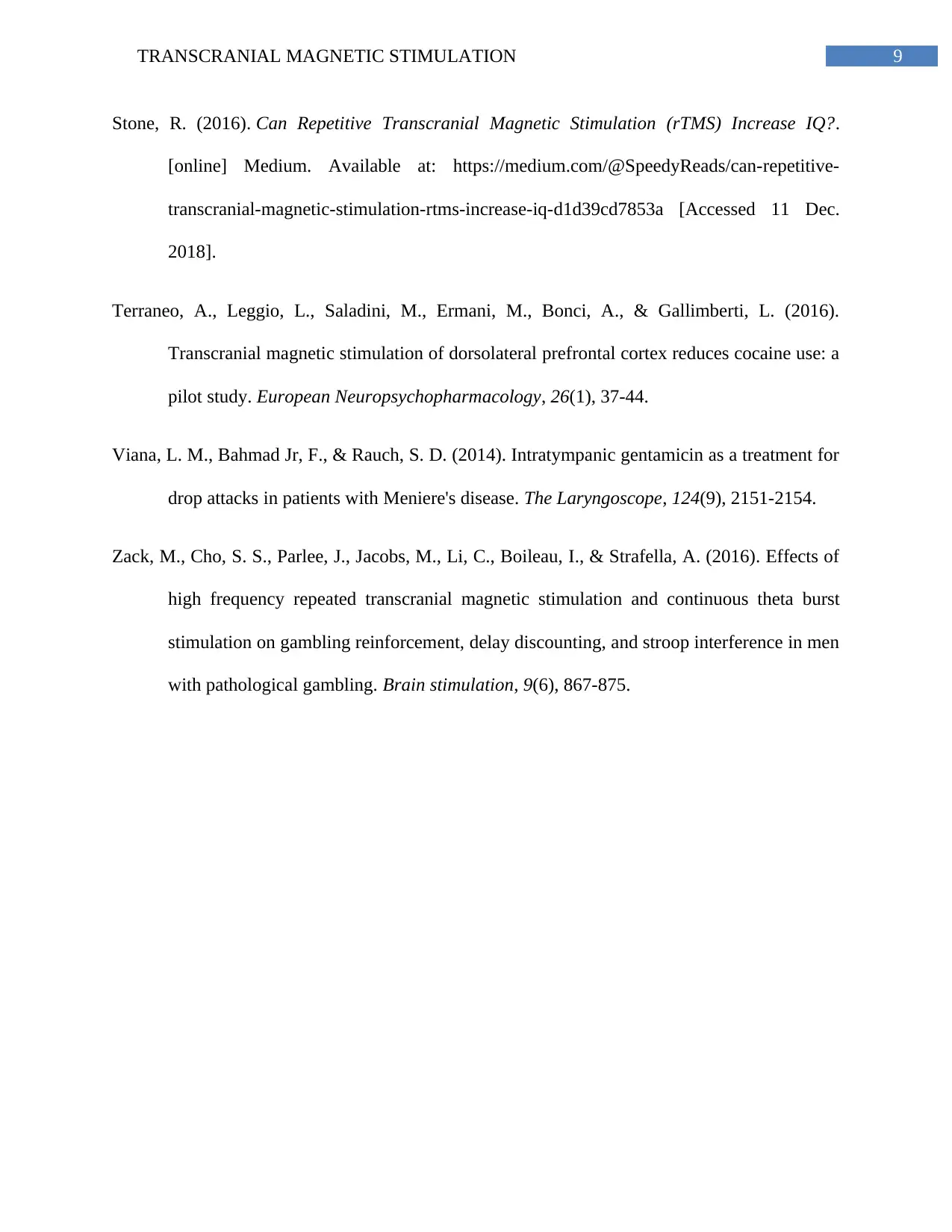
9TRANSCRANIAL MAGNETIC STIMULATION
Stone, R. (2016). Can Repetitive Transcranial Magnetic Stimulation (rTMS) Increase IQ?.
[online] Medium. Available at: https://medium.com/@SpeedyReads/can-repetitive-
transcranial-magnetic-stimulation-rtms-increase-iq-d1d39cd7853a [Accessed 11 Dec.
2018].
Terraneo, A., Leggio, L., Saladini, M., Ermani, M., Bonci, A., & Gallimberti, L. (2016).
Transcranial magnetic stimulation of dorsolateral prefrontal cortex reduces cocaine use: a
pilot study. European Neuropsychopharmacology, 26(1), 37-44.
Viana, L. M., Bahmad Jr, F., & Rauch, S. D. (2014). Intratympanic gentamicin as a treatment for
drop attacks in patients with Meniere's disease. The Laryngoscope, 124(9), 2151-2154.
Zack, M., Cho, S. S., Parlee, J., Jacobs, M., Li, C., Boileau, I., & Strafella, A. (2016). Effects of
high frequency repeated transcranial magnetic stimulation and continuous theta burst
stimulation on gambling reinforcement, delay discounting, and stroop interference in men
with pathological gambling. Brain stimulation, 9(6), 867-875.
Stone, R. (2016). Can Repetitive Transcranial Magnetic Stimulation (rTMS) Increase IQ?.
[online] Medium. Available at: https://medium.com/@SpeedyReads/can-repetitive-
transcranial-magnetic-stimulation-rtms-increase-iq-d1d39cd7853a [Accessed 11 Dec.
2018].
Terraneo, A., Leggio, L., Saladini, M., Ermani, M., Bonci, A., & Gallimberti, L. (2016).
Transcranial magnetic stimulation of dorsolateral prefrontal cortex reduces cocaine use: a
pilot study. European Neuropsychopharmacology, 26(1), 37-44.
Viana, L. M., Bahmad Jr, F., & Rauch, S. D. (2014). Intratympanic gentamicin as a treatment for
drop attacks in patients with Meniere's disease. The Laryngoscope, 124(9), 2151-2154.
Zack, M., Cho, S. S., Parlee, J., Jacobs, M., Li, C., Boileau, I., & Strafella, A. (2016). Effects of
high frequency repeated transcranial magnetic stimulation and continuous theta burst
stimulation on gambling reinforcement, delay discounting, and stroop interference in men
with pathological gambling. Brain stimulation, 9(6), 867-875.
1 out of 10
Your All-in-One AI-Powered Toolkit for Academic Success.
+13062052269
info@desklib.com
Available 24*7 on WhatsApp / Email
![[object Object]](/_next/static/media/star-bottom.7253800d.svg)
Unlock your academic potential
Copyright © 2020–2025 A2Z Services. All Rights Reserved. Developed and managed by ZUCOL.
